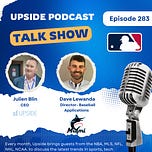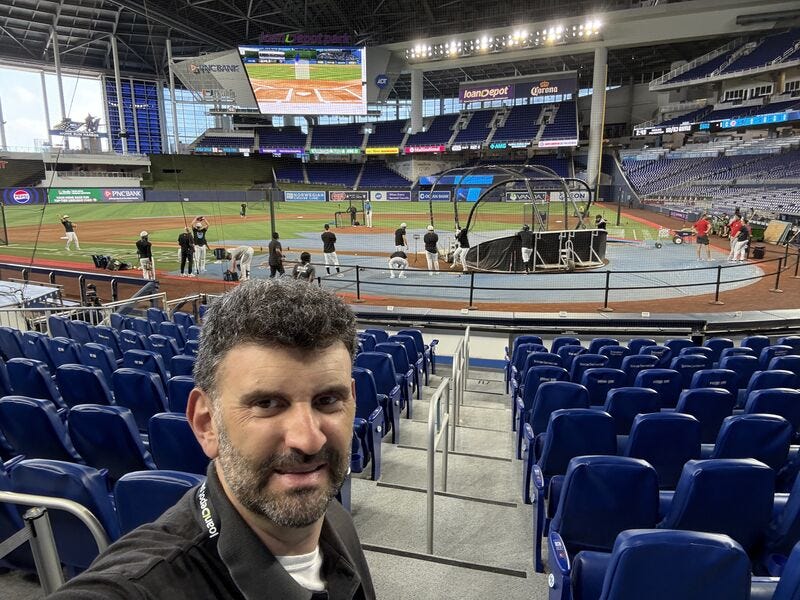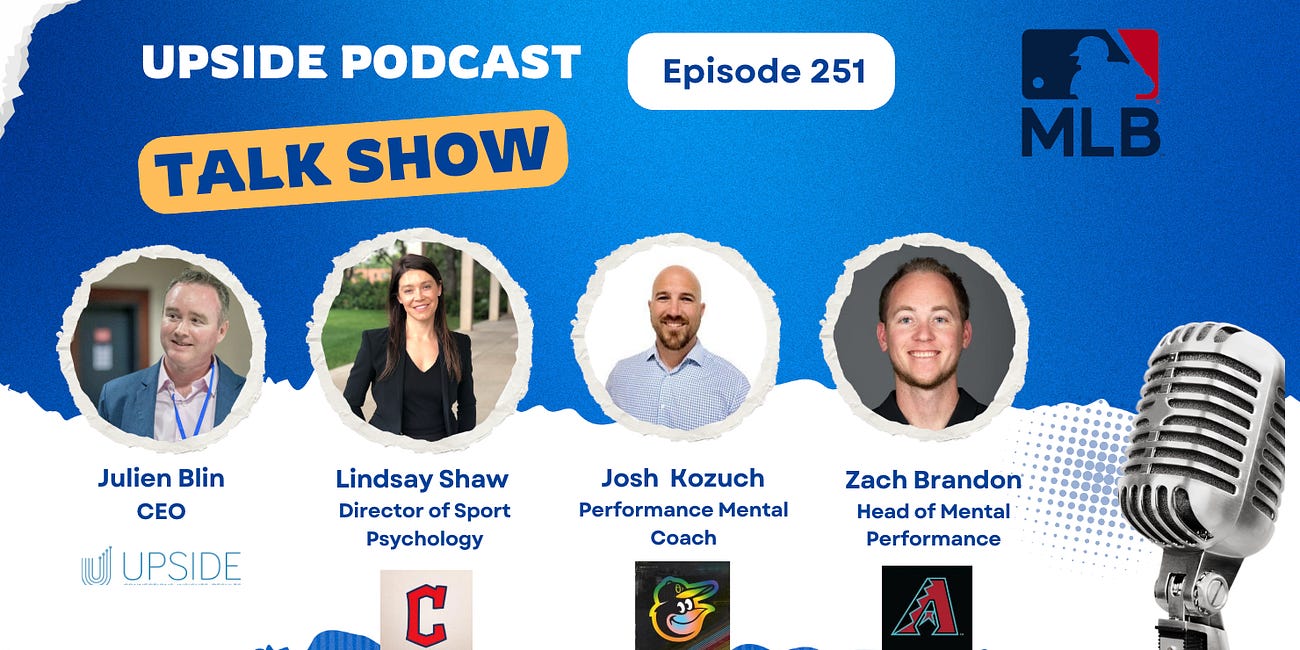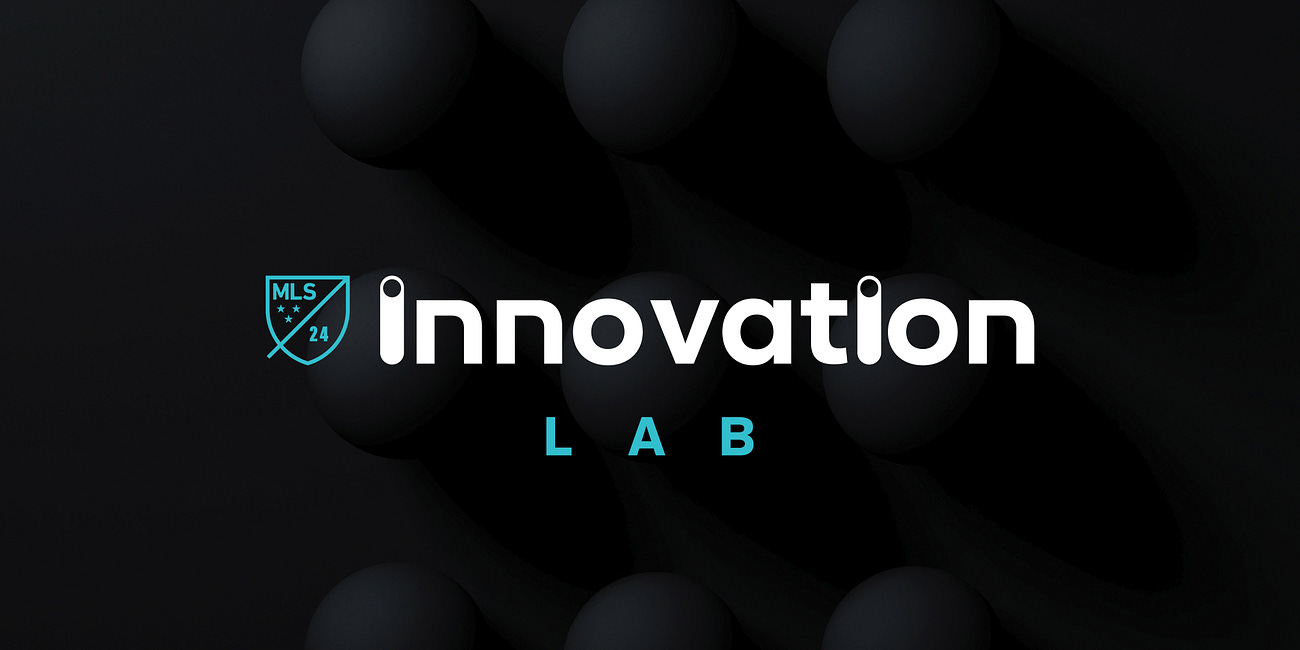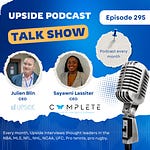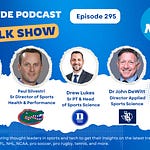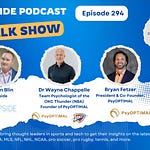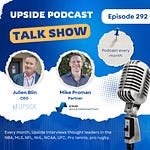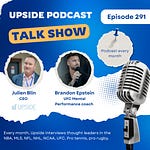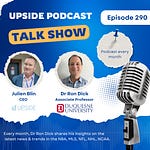Today we have the honor of interviewing Dave Lewanda, the Director of Baseball Applications at the Miami Marlins, an MLB team.
You can watch the video interview below by clicking on the Youtube link. You can also listen to the audio interview by clicking on the link at the top of the page:
Here is a picture of Dave on the field:
📝Show Notes: Through this interview, we touched on Dave’s professional journey and what led him to become Director of Baseball Applications at the Miami Marlins, including the key experiences that shaped his path into sports technology. We explored how he approaches innovation in a tradition-rich sport like baseball and the ways his team bridges legacy systems with new, data-driven applications.
The conversation also delved into how he balances the needs of diverse stakeholders—from coaches and players to analysts and executives—when developing software tools for the organization. We discussed the broader sports technology landscape, where he sees the greatest opportunities for innovation, and how AI is already influencing workflows and decision-making. Finally, we looked ahead to his vision for the future of sports tech, including the growing roles of AI, automation, computer vision, and emerging technologies in shaping the next generation of baseball performance and operations.
You can read the full transcript of the podcast interview with Dave located at the top of this blog post.
Here are the quotes from the interview with Dave:
🧩 Q1. Background & Path
“I’ve been in technology, specifically software engineering, for over 20 years now. I grew up in central Connecticut, just outside of Hartford, and I’ve always had a deep interest in both technology and sports. I was never much of an athlete—I flamed out of Little League at 11 years old and only played golf casually—but I was always fascinated by how technology could intersect with sport.”
“I studied computer engineering at Lehigh University, where I earned both my bachelor’s and master’s degrees. From there, I started my career working for a Department of Defense contractor, then moved into television broadcast technology, and later into consumer electronics at companies like Samsung.”
“My transition into sports came when I joined Major League Baseball’s New York office, working on the consumer-facing MLB app. That was really a defining moment for me—getting to merge my engineering background with my lifelong love of baseball. As Director of Software Engineering for MLB, I led the team responsible for the MLB app on Apple platforms, working closely with Apple to bring fans scores, videos, and live updates.”
“After five and a half years there, I joined Diamond Kinetics, a sports tech startup out of Pittsburgh that focused on baseball and softball training technology. That experience gave me a deeper appreciation for how data, analytics, and hardware can come together to help athletes at every level.”
“And now, joining the Miami Marlins has been incredibly exciting. We’ve just wrapped up a really successful season—17 more wins than last year—and we’re pushing hard to integrate analytics and technology to help the team put the best possible product on the field. I feel like I’ve come full circle—bringing my tech experience directly to where it can make a difference in competition.”
⚙️ Q2. Innovation in Baseball
“I’ve always been a fan of Moneyball—and I like to say I read the book before it was a movie. Baseball has always attracted the ‘stat nerds’ because it’s so state-driven. There’s no clock, and so many small, variable events determine the outcome. It’s the perfect sport for data because there are so many permutations and little moments that matter.”
“In other sports, you can give the ball to Patrick Mahomes or LeBron James and know they can directly influence the game. Baseball isn’t like that. You can’t control every play, and that unpredictability is what makes analytics and modeling so critical. There’s so much information that can give you an edge.”
“Our role in the Baseball Applications team is to leverage all of that data—from player tracking to scouting reports—and figure out how to present it in a meaningful way for each user. That could be the front office trying to decide who to draft or trade for, or the coaching staff trying to help a player improve today.”
“We see our mission as enabling the organization to ‘get better players and get players better,’ as our President of Baseball Operations puts it. And that means replacing applications that bridge the legacy systems our team has relied on for years with new, more dynamic technologies that support real-time analysis and decision-making.”
🧰 Q3. App Development & Workflow
“Before this role, I spent most of my career building products for mass consumption—where your goal is to grow revenue, maximize daily active users, and analyze usage data at scale. At MLB, for instance, the app had millions of active users during the season.”
“With the Marlins, I’m now building tools for maybe a few dozen people—coaches, analysts, scouts, and front office staff. That’s an entirely different kind of challenge. The impact is smaller in numbers, but much greater in depth. I can meet directly with users, understand exactly what they need, and design tools that are essential to their jobs.”
“For me, earning their trust is everything. They need to believe that the tools we create will help them, not slow them down. I often say I want our apps to be like power steering or anti-lock brakes—technology that enhances performance so seamlessly that people don’t have to think about it. When they need to make a quick decision, they can rely on the tool without hesitation.”
“The other big advantage we have is the opportunity to build something fresh. Unlike other teams who’ve been layering on technology for years and have to deal with technical debt, we get to start with a clean slate. We have an older system that we’re keeping on life support while we build its replacement, and that’s a dream scenario for any software engineer—creating a modern, purpose-built system that truly fits our users.”
“And because many people on our team have worked in other organizations—both inside and outside of baseball—we can learn from what’s worked elsewhere and avoid repeating past mistakes. That’s been a huge benefit in shaping our roadmap.”
🚀 Q4. Sports Tech Landscape
“The biggest opportunity in sports tech right now? Efficiency and intelligence. Every team, at this point, must be thinking about AI. For us, as a small engineering team of four going to maybe six, we’ll never be a 30-person department—so we have to think like a startup. That means using AI tools like GitHub Copilot and OpenAI’s Codex to speed up our development and make better use of our time.”
“But beyond coding, large language models open a whole new world for summarizing data. Think about scouting reports: a player might have hundreds of reports from different scouts, all slightly different. LLMs can synthesize those into key themes, trends, and summaries instantly. That’s incredibly powerful for analysts and executives who need to make fast, informed decisions.”
“We’re still early in that process—I like to say we’re crawling, not walking yet—but ignoring AI would be a huge mistake. It’s clearly here to stay. While there’s a lot of hype around it, there’s also real substance. AI isn’t going away. It’s going to become part of the foundation of how every sports organization operates.”
🌐 Q5. Vision & Future
“When I was at MLB, I saw firsthand how quickly the technology advanced. Back in 2017, the motion tracking systems in ballparks had a resolution roughly the size of a watermelon. By the time I left in 2022, that resolution had improved to the size of an M&M. That’s multiple orders of magnitude more precise—and that level of precision completely changes what’s possible.”
“Computer vision, motion capture, and 3D modeling are transforming the sport. We can now analyze a player’s swing mechanics or pitching delivery frame by frame, compare performance over time, and even detect subtle changes—like a player’s hand position—when things are going well versus when they’re not.”
“Injury prevention is another huge area. If you can track fatigue, stress, or workload in real time, you can potentially prevent injuries before they happen. Every team would love to avoid losing a pitcher for 12 to 24 months to Tommy John surgery. There’s a massive opportunity for AI, wearables, and predictive modeling to work together there.”
“And automation is coming, too. We’re already seeing AI-controlled cameras in some minor league parks that can follow plays automatically, replacing some of the traditional camera operations. There are even companies developing AI-generated audio commentary and summaries. We’re not looking to replace people, but the efficiency gains are real and significant.”
“Ultimately, I see a future where all these technologies—AI, computer vision, mixed reality, even quantum computing—work together to help us make faster, smarter, and more data-driven decisions across every part of the organization. The teams that embrace that now will be the ones who thrive in the coming years.”
You may also like:
⚾ Upside MLB Group Video Chat with Lindsay Shaw (Guardians), Zach Brandon (Arizona Diamondbacks), Josh Kozuch (Baltimore Orioles) on Mental Performance
Today we have the honor of interviewing a group of MLB practitioners that are experts in mental performance and preparation.
⭐Upside VC Profile: MLS Innovation Lab & Chat with Chris Schlosser, SVP of Emerging Ventures (MLS)
Accelerator name: MLS Innovation Lab

